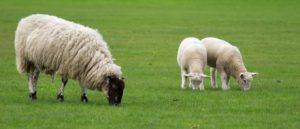Sheep farmers face a number of choices when it comes to managing how their animals graze grass. Typically, grassland growth rates should determine how long grass should be grazed and rested for and will, therefore, have a bearing on the grazing method chosen. Growth rates are influenced by a number of factors including season, weather, soil structure and soil nutrients, and may vary from field to field, and even within individual fields – depending on size, geography and the stocking rate.
With continuous grazing, a fixed area of land is normally grazed non-stop for a specific period. Time-frames vary from just a few weeks to the entire grass-growing season. Continuous grazing can be controlled or uncontrolled. To maintain a productive field in an uncontrolled, continuously grazed system it’s important to avoid under- or over-grazing by maintaining the correct grazing pressure and adjusting stocking rates accordingly. Continuous grazing can lower grass production and persistency so it’s vital to pick a suitably hardy grass variety. It’s
also important to ensure that a field used for continuous grazing has more than one water source. Animals like to gather around watering points, which means recycled nutrients can become concentrated in one area. Providing multiple drinking points will ensure nutrients get evenly spread across a wider area. Having more than one water trough will also help minimize poaching when conditions are wet.
Rotational grazing
Rotational grazing is where fields are subdivided and then grazed and rested alternately. Once one field has been grazed, livestock are moved to a new patch of grass. The first field is then rested and the sward is given time to regenerate. Some farmers have a rotational grazing pattern of one to two weeks. Others opt for a more intense approach – moving livestock every few days. This method provides more control over what animals are eating and can result in better plant growth but requires more land and can be time-consuming from a land management perspective.
Creep grazing
Creep grazing is when young animals are allowed to move onto an area of grass ahead of older livestock to gain access to better quality forage. This method of grazing works well within a rotational grazing system, giving lambs access to the top layer of more succulent, nutritious grass, which enables them to gain weight more quickly. Creep grazing is typically managed via a series of fences or gates that only allow smaller animals into a designated area first.
Mixed grazing
Grazing different animals together can have huge benefits in terms of grassland management and can increase grass utilisation. Different species of livestock prefer different types of forage and have different in-take levels. Sheep will generally always opt for immature grasses and weeds over legumes, while cattle generally prefer legumes to grasses. Cattle and sheep also eat differently. While cattle use their tongues to pull and tear, sheep use their teeth to nibble, grazing much closer and getting into parts of the pasture that cattle either ignore or can’t reach. This can increase grass tillering and sward productivity – meaning animals will, long-term, gain more weight.
Sheep enterprises do not graze beneath 4cm and do not be tempted to graze too early as the plants will not have accumulated enough energy reserves. In the long term, all this would achieve is to reduce pasture quality and persistence.
If you are unsure about grass levels, try using a sward stick – speak to your local NWF Sales Specialist, call on 0800 756 2787 or email nbteam@nwfagriculture.co.uk to receive your free NWF Sward Stick.
For more information or to order our wide range of grass seeds, click HERE.
